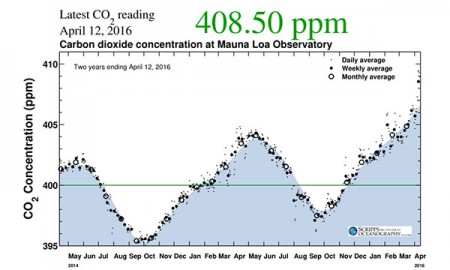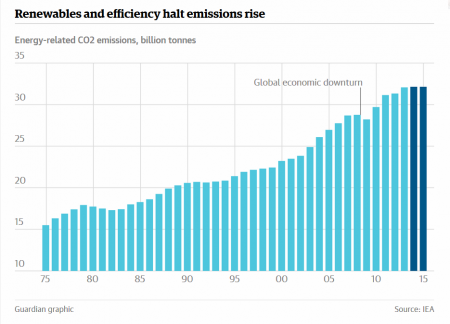April 16, 2016 – Last week at the top of Hawaii’s Mauna Loa, carbon dioxide (CO2) concentrations in the atmosphere were measured at 409.44 ppm. On April 12 the reading was 408.5. Anyway you look at it these two values represent a rise of close to 5 ppm in one year and the highest single year increase since 1998 when CO2 levels rose 3.7 ppm.
This number will abate as the Earth inhales and exhales in its annual cycle. With summer about to arrive in the northern hemisphere new plant growth will perform as a carbon sink sucking CO2 from the air. But don’t expect to see the cyclical drop to go below 400 ppm as has happened in recent years.
The recorded accumulated rise since March 1958 when the first measured at Mauna Loa has now increased by nearly 100 ppm. And 12 other sites around the globe verify that the levels observed in Hawaii can be found everywhere.
In the past month newspapers have reported that our shift to renewables and the decline in coal use has stalled anthropogenic CO2 emissions these last two years. In its latest report the International Energy Agency states that its sector released 32.1 billion tons of CO2. Other human industrial activity make up the balance of the estimated 40 billion metric tons of CO2 released.
So why did Mauna Loa record a spike? There are several reasons:
- The deliberate burning of forests and brush in Indonesia to clear the land for agricultural use.
- A general increase in wildfires resulting from many areas experiencing prolonged drought.
- The El Nino which in 1998 was a major contributor to the CO2 spike that year and has achieved a similar impact in 2015.
Climatologists have noted that El Ninos cause CO2 levels in the atmosphere to rise. One of the reasons is the warmer ocean surface water associated with El Nino events releases CO2 into the atmosphere. The location of the warming surface waters also plays a role by altering tropical rainfall patterns leading to droughts and die offs which turns normal carbon sinks into emitters.
And here is a more significant issue. Although we have seen a 5 ppm rise this year it has happened during the El Nino. If we look at past El Nino CO2 boosts the gas post-El Nino rises even higher. That may mean we will see in 2016 and 17 even more significant spikes in CO2.
At 400 ppm we have witnessed a rise in global mean temperatures of 1 Celsius (1.8 Fahrenheit). With every uptick in the CO2 counter climatologists expect annual mean temperatures to rise even further. And when you consider that this March was globally the hottest in recorded history it’s disconcerting to look at the snail’s pace level of progress our political leadership is making in addressing policy to begin to mitigate the growing crisis. How much longer can we be the frog in pot of water sitting on top of a stove burner?











